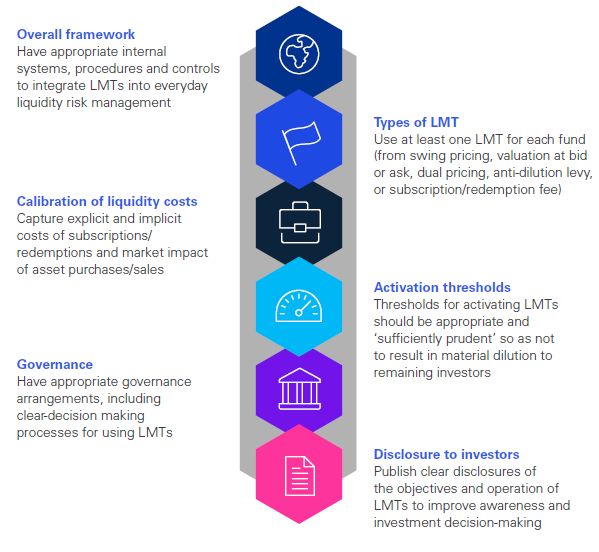Asset managers continue to play an increasingly important role in financial markets and funding the real economy. According to the FSB1, recent growth in non-banks' share of global financial assets has been driven by investment funds. Therefore, policymakers continue to focus on the asset management industry and potential financial stability risks. The FSB and IOSCO2 share a priority to enhance the resilience of non-banks, along with concerns about general market volatility and cyber threats (see Chapter 4).
Liquidity management in open-ended funds (OEFs) is under the spotlight. Money market fund (MMF) reforms are more advanced but slowing, with regulators now taking stock of progress. A few regulators have remaining concerns about exchange-traded funds (ETFs), and a recent area of focus in Europe has been liability-driven investment strategies. Use of leverage, investments in private and real assets, and asset valuation also feature on regulatory agendas.
See below for more details on key themes
Significant analysis and evaluation work has been completed by regulators on liquidity management in OEFs, since the 2020 “dash for cash” episode. Although there continues to be a difference of opinion between central banks and securities regulators on the extent of vulnerabilities in OEFs, they have both pushed ahead with parallel policy proposals to tighten up liquidity management practices.
IOSCO reviewed the implementation of its 2018 recommendations and found a “high degree of implementation” among jurisdictions. However, it also identified certain “gaps and shortcomings”. This work fed into the FSB's review of the effectiveness of its 2017 recommendations. Both bodies then published specific proposals in July 2023, which will be followed by final reports at the end of 2023.
IOSCO consulted on guidance to support greater and more consistent use of liquidity management tools (LMTs), including a list of relevant LMTs (of which at least one should be used), how dilution adjustments should be calculated (including explicit and implicit transaction costs, as well as estimated market impact), and governance and disclosure frameworks. The FSB proposed detailed amendments to its recommendations, including changes to reduce structural liquidity mismatch in funds by grouping funds into categories with associated requirements (e.g. a fund investing mainly in illiquid assets would need to have a redemption frequency less than daily), and to increase the availability and use of LMTs. There is also a wider focus on promoting system-wide stress testing and closing data gaps.
The International Monetary Fund (IMF) also published recommendations, including the need for further guidance to ensure that LMTs are used and calibrated appropriately, and for tighter monitoring by supervisors. The IMF believes that OEFs that offer daily redemptions while holding illiquid assets can “amplify the effects of adverse shocks by raising the likelihood of investor runs and asset fire sales”.
Many national regulators have pushed ahead with their own policies and supervisory work, underlining the significant, worldwide focus in this area. Examples include:
- The US SEC3 proposed changes to prepare OEFs better for stressed conditions and to prevent exiting investors diluting fund value for remaining investors: requiring OEFs to implement swing pricing; introducing a “hard close” to mitigate operational issues; improving funds' classification of liquidity by establishing new minimum standards; limiting the extent of investment in more illiquid securities; and increasing the frequency of public disclosures.
- The Swedish regulator is introducing new rules on swing pricing. With permission from the regulator, funds may implement swing pricing provided the fund manager has appropriate systems and controls, and it is in investors' best interests.
- Brazil's new fund regime introduced LMTs such as gates and side pockets, as well as creating an insolvency regime for funds when net assets become negative.
- The UK FCA4 completed a supervisory review and noted the need for improvements across fund managers' governance frameworks and structures, liquidity stress testing, unit redemption process and use of LMTs. It invited views on amendments to rules on liquidity stress testing and clarification of the rules on certain LMTs, and is also considering whether additional liquidity reporting or public disclosure for UK retail funds are necessary.
- The Monetary Authority of Singapore (MAS) will be sharing good practices to help asset managers strengthen their risk management and compliance capabilities, including observations on liquidity risk management practices.
- The EU review of the AIFMD5 framework includes a requirement for fund managers to choose at least two LMTs in addition to fund suspension, and for firms to notify supervisors when they activate an LMT.
- Although new LMTs were made available to German fund managers in spring 2020, a survey by the regulator found most fund managers had not introduced any new LMTs as of May 2022. The regulator will therefore continue to monitor developments and has designated LMTs as a special area of focus. There is a sense that swing pricing is becoming more popular in the industry.
- The French AMF6 clarified its requirements in autumn 2022, signaling a clear policy goal to increase the availability of LMTs in funds, by providing more guidance, increasing disclosure requirements where funds do not use LMTs, and aligning its approach to different LMTs where possible.
- The Cyprus regulator published new guidance focused on due diligence of investments (e.g. their liquidity profile), presumptions of liquidity at the pre-investment stage, ongoing monitoring of liquidity risk, the use of data, and governance and control mechanisms.
- In the Netherlands, fund liquidity management is a supervisory focus for the AFM7, which is increasing its monitoring.
- The Central Bank of Ireland (CBI) invited views on a macroprudential framework for funds, describing this as “the missing ingredient” in the regulatory toolkit. A July 2023 paper identified potential systemic risks posed by the funds sector and covered the objectives of the macroprudential framework, principles to underpin its design, tools to achieve macroprudential objectives and a range of practical issues to be tackled. The CBI had already published a framework for property funds, which must now have a minimum liquidity timeframe of 12 months and a leverage limit of 60 percent total debt to total assets.
On the topic of system-wide oversight, the Bank of England launched its first system-wide exploratory scenario to understand the behaviour of UK banks and non-banks in stressed market conditions. The exercise will gather data from asset managers, including pension schemes, hedge funds and OEFs. The Canadian securities administrators published the results of their first annual systemic risk survey of firms — respondents were most concerned about rising interest rates, household debt, the housing market, the geopolitical environment, and cyber vulnerabilities.
Supervisors have conducted hypothetical stress tests. For example, the Luxembourg regulator simulated redemption shocks to funds with over EUR 1.1 trillion of assets. It found that 83 percent of funds could meet redemption shocks within two days and 96 percent within five days. Similarly, the Swedish regulator developed a stress testing tool to analyze funds' resilience. It found that some bond funds could experience liquidity problems in stressed market conditions.

MMF reform has continued. Later in 2023, the FSB and IOSCO will take stock of the policy measures adopted by jurisdictions in response to the FSB's 2021 recommendations. The findings are expected to be published by the end of the year.
Japan has already revised its framework to improve the resilience of MMFs. In the US, the SEC also adopted amendments to its rules. These changes will increase the minimum liquidity requirements for MMFs, remove the ability for MMFs to temporarily suspend redemptions via gating, and allow certain MMFs to impose liquidity fees when they have daily redemptions that exceed 5 percent of net assets.
In Europe, the UK is considering feedback to a 2022 discussion paper before further consultation and in the EU, the European Commission finalized a report. It found that the regulatory framework for MMFs has worked as intended but there are shortcomings to be assessed further. Potential changes could involve decoupling the activation of LMTs from liquidity thresholds.
ESMA8 has been particularly active. It issued reports, updated its annual stress testing guidelines, and consulted on a review of the methodology of the stress test scenarios. It considered introducing a new climate risk scenario for the first time but decided against it at this stage.
ETFs continue to attract the attention of some regulators given their growth. The IMF recognized that vulnerabilities in ETFs are different to other OEFs, but referenced evidence that ETFs can increase volatility in markets and amplify the sensitivity of cross-border capital flows to global financial conditions.
IOSCO concluded that its 2013 principles remain relevant and there are no major gaps, but it published good practices intended to support the principles and highlight issues for consideration by regulators, fund managers and trading venues.
Poland continues to work on amendment of its ETF regime, to help develop capital markets and protect investors. The proposed rules would simplify the process to create Polish ETFs, allow them to be UCITS9, and disapply the general prospectus regulations.
IOSCO found that average leverage levels in funds had not changed, but with some variations, including declines in leverage levels in hedge funds.
The EU regulators called for vigilance in the face of mounting risks and specifically noted the need to monitor liquidity risks arising from investments in leveraged funds and the use of interest rate derivatives. The CBI was the first EU national regulator to use a power under AIFMD to impose leverage limits where there could be potential risks to financial stability. As noted above, in November 2022, it imposed a 60 percent leverage limit on certain Irish real estate funds, with a five-year transitional period for existing funds. The authorities in the Netherlands will focus on the use of leverage in funds and the possibility of imposing leverage limits when systemic risks arise.
The EU's AIFMD review has introduced the definition of a loan-originating fund (i.e. funds that provide credit) and the amount of risk they should retain, as well as a leverage cap designed to mitigate potential financial stability risks.
Volatility in the UK gilt market in September 2022 and associated challenges for LDI managers added to scrutiny of the non-bank sector. In response, regulators set new expectations and laid out follow-up supervisory and policy work. The Bank of England said that the root cause was simple — and had been seen in other contexts — poorly managed leverage.
In November 2022, the UK FCA published a statement to recap its expectations on risk management and required asset managers to take appropriate action to factor market conditions into their risk management practices. The CBI and CSSF10 published identical letters to Irish and Luxembourg LDI fund managers, asking them to maintain the current level of resilience and the reduced risk profile of GBP LDI funds. Managers wishing to reduce funds' yield buffers needed to notify them and provide a justification. Meanwhile, the Bank of England judged that the size of the yield shock to which LDI funds should be resilient should be at least 250 basis points.
In April 2023, the FCA and the UK pensions regulator issued further guidance, observations, and recommendations. Notably, the FCA stated that other types of firms that may face similar types of risk should also consider the findings and lessons learned. In a similar vein, the Financial Stability Committee in the Netherlands recommended that the regulators conduct risk-based follow-up work on a previous investigation to identify liquidity challenges that could arise in exception times of stress, with the aim of developing good practices.
Following concerns about inconsistency in the valuation quality and approach around the world, IOSCO and the International Valuation Standards Council signed a statement of co-operation to explore how best to promote high-quality valuation practices.
In June 2023, the Securities and Exchange Board of India wrote to alternative investment fund (AIF) managers to promote a standardized approach to the valuation of investment portfolios. It reminded firms of the relevant regulations, set out the responsibilities of the fund manager, provided more detail on the criteria for independent valuers, and clarified reporting requirements to performance benchmarking agencies.
ESMA required EU national regulators to review supervision of the asset valuation rules for EU UCITS and AIFs. It found room for improvement in four areas and noted the importance of "paying close attention to potential valuation issues arising from less liquid assets", specifically private equity and real estate assets. ESMA will facilitate further discussions among EU supervisors, particularly regarding stressed market conditions. The AFM in the Netherlands reminded real estate fund managers of the importance of good valuation procedures and issued guidelines to tighten valuation procedures.
The MAS plans to share good practices on asset valuation and investment due diligence with Singapore firms. The US SEC also plans to focus on valuation, following the introduction of new rules in 2021. It is assessing firms' and funds' compliance with the requirements for determining fair value, and reviewing whether aspects of firms' approaches have been appropriately adjusted, including valuation methodologies, compliance policies and procedures, and oversight and governance.
IOSCO identified private finance as a new priority. It has asked regulators to explore whether behaviors in these markets could have impacts or negative spillovers on public markets, particularly as the economic environment adjusts to higher inflation and rising interest rates. It will assess emerging risks and vulnerabilities in the sector and undertake follow-up work.
The US SEC has already adopted changes to enhance private funds' reporting obligations. Amendments to Form PF should better enable US authorities to assess systemic risk and bolster the SEC's oversight of private fund advisers and its investor protection efforts. Alternative managers must report events that could indicate significant stress at a fund or investor harm. Large private equity advisors would also need to report information on “claw backs” on an annual basis, and additional information on their strategies and borrowings.
In Saudi Arabia, the CMA11 issued instructions in 2022 around direct financing investment funds, which set out specific conditions for establishing such funds, investment limitations and additional duties, particularly around credit sanctioning and monitoring. Amongst other changes in China (see Chapter 8), wide-ranging new rules have been issued for the private fund industry, which seek to mitigate potential risks arising from the industry.
The availability and cost of market data is a common challenge across jurisdictions. The Canadian securities regulators are considering reforms in two stages. In the short-term, they have consulted on changes to address fragmented information about orders and trades in equity securities. Longer-term options might be an overhaul of the regulatory regime for accessing consolidated real-time market data.
There are similar considerations in Europe, where in both the EU and the UK there are measures to support the emergence of “consolidated tapes”. The tapes will collate market data from all trading platforms and publish the information as close as possible to real time, helping investors to access price and volume information. The commercial model of the tapes was strongly debated in the EU and industry has voiced concerns about the practical usability of the compromise arrangement reached. Meanwhile, the UK FCA proposed a consolidated tape first for bonds, followed by equities. The FCA found that the market could more effectively allow competition and innovation, to reduce concentration and complexity around how data are sold. It is investigating further.
The structure of bond markets is also under scrutiny. Responses to IOSCO's review of drivers of liquidity in corporate bond markets during the pandemic supported work to increase liquidity in these markets. The FSB has suggested ways to enhance the resilience of liquidity supply in times of stress, such as by using central clearing for government bond cash and repo transactions, and the use of all-to-all trading platforms.
As some jurisdictions such as the US and Canada move towards T+1 settlement, there will be implications for international asset managers as they will need to support both T+1 and T+2 cycles. For example, there may need to be changes in operational flows for asset managers that need to settle an FX trade (usually settled T+2) to fund a securities trade settling in T+1. This challenge is heightened for less liquid currencies and investors in Asia Pacific time zones.
The relationship between index providers and asset managers is once more under the spotlight. IOSCO published a survey to gather information on the nature of the interaction between these parties, and on their governance and processes during exceptional market events and shocks.
Markets in crypto-assets are seen as a potential area of systemic risk. We comment on the regulation of such assets in Chapter 5.
Actions for firms:
Tighten up governance arrangements around the use of liquidity management tools for open-ended investment funds, and the fair treatment of all investors.
Evaluate the effectiveness of the stress testing process by reconsidering the scenarios used and whether they incorporate all plausible external and operational events.
For ETF managers, review and implement IOSCO's good practices — for example, around the effectiveness of due diligence on authorized participants and market makers.
Review asset valuation policies and procedures, ensuring they clearly describe roles and responsibilities, distinguish between normal and stressed market conditions, and include a mechanism to identify and remediate valuation errors.
Consider preparedness for new reporting obligations and revise systems, roles and responsibilities as needed.
Re-assess due diligence arrangements over index and data providers, and ensure that each party's roles and responsibilities are clear.
Key topics captured within the report
Contact us
Connect with us
- Find office locations kpmg.findOfficeLocations
- kpmg.emailUs
- Social media @ KPMG kpmg.socialMedia
Stay up to date with what matters to you
Gain access to personalized content based on your interests by signing up today
Related content
1Financial Stability Board
2International Organization of Securities Commissions
3Securities and Exchange Commission
4Financial Conduct Authority
5EU Alternative Investment Fund Managers Directive
6Autorité des Marchés Financiers
7Autoriteit Financiële Markten
8European Securities and Markets Authority
9Undertaking for collective investment in transferable securities
10Commission de Surveillance du Secteur Financier
11Capital Market Authority












